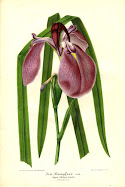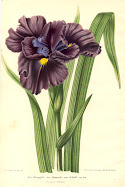
The weather seasons of the Manawatu in the late 1980's /early 1990's had become unsettled and brought much rain during the spring and summer months which made growing breaded irises somewhat of a problem with so much rot in the rhizomes that I need other types of Iris to cope with the moist soils of the garden.
My first Siberian iris along with the Japanese irises that I had, did so well and surpassed the expectations of all my other irises with the excepting of the water loving irises. I. louisiana and I. laevigata.
In the Siberian irises, one cultivar in particular stood out from all the rest. This was called I. siberica"Caesar's Brother" which was introduced in the early 1930's.
 It had grown so well that I divided 20 huge ten year old clumps for replanting in a wet area of my lawn around some Silver birches. Once I had sprayed this large area of lawn for weeds, It was now ready to complete the next stage. With the generous help of my friends and myself, we began the task of planting the iris divisions during mid winter into the soil spacing them about 1 metre apart to allow them to grow as individual plants on mass in a drift. 1400 divisions formed this huge drift and at that time I could only imagine what they may look like as time progressed to grow into huge clumps themselves. As the years skipped by in the third year these plants produce thousands of magnificent blooms all over the drift of Siberian iris plants. The flowers lay like a carpet of deep sea blue floating in the breeze like butterflies in flight.
It had grown so well that I divided 20 huge ten year old clumps for replanting in a wet area of my lawn around some Silver birches. Once I had sprayed this large area of lawn for weeds, It was now ready to complete the next stage. With the generous help of my friends and myself, we began the task of planting the iris divisions during mid winter into the soil spacing them about 1 metre apart to allow them to grow as individual plants on mass in a drift. 1400 divisions formed this huge drift and at that time I could only imagine what they may look like as time progressed to grow into huge clumps themselves. As the years skipped by in the third year these plants produce thousands of magnificent blooms all over the drift of Siberian iris plants. The flowers lay like a carpet of deep sea blue floating in the breeze like butterflies in flight.I. siberica "Caesar's Brother" continues each year to provide an impressive display.
As the years roll by, these plants that grow into clumps will in turn need more freedom to grow and flourish so by lifting the huge clumps and dividing again to put into fresh soil should be done in order to give that fantastic display of our achievements we planted all over again.
 So where to find more Siberian iris. Many of the nurseries in New Zealand have a very poor selection of varieties available to purchase. Many of the same variety had different names.
So where to find more Siberian iris. Many of the nurseries in New Zealand have a very poor selection of varieties available to purchase. Many of the same variety had different names.There are a small handful of specialised growers in New Zealand that have an exciting range of culitvars which is hoped that these irises will been seen on the New Zealand market over the next few years.
Additional info:
I. siberica "Caesar's Brother" is a rich dark blue - royal purple which was introduced by the pioneer Canadian breeder of Siberian irises, F. Cleveland Morgan, in 1931. Three years after it's introduction this iris received an (HM) an Honorable Mention in 1936 and went on to win the prestigious Morgan-Wood award in 1953, the awarding agency being the American Iris Society. This is the highest award specifically for a Siberian iris.
F. Cleveland Morgan was a founding member of the A.I.S. His works of magnificent cultivars still enhance gardens around the world. His best known cultivars are 'Caesar', 'Caesar's Brother' and 'Tropic Night'.
This cultivar 'Caesar's Brother' is available in nurseries throughout New Zealand.





No comments:
Post a Comment